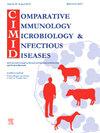Molecular screening for blood pathogens in synanthropic Pipistrellus bats in Spain reveals novel and human-related hemoplasmas
IF 2
3区 农林科学
Q4 IMMUNOLOGY
Comparative Immunology Microbiology and Infectious Diseases
Pub Date : 2025-09-20
DOI:10.1016/j.cimid.2025.102404
引用次数: 0
Abstract
Urbanization profoundly alters natural habitats, creating environments where adaptable species such as bats thrive. In developed countries, cities may act as hotspots for pathogen transmission from bats to humans, yet urban bat pathogens remain understudied in Europe. This study examined vector-borne and zoonotic bacteria and protozoa in soprano (Pipistrellus pygmaeus, PPY) and Kuhl’s pipistrelles (Pipistrellus kuhlii, PKU) inhabiting Zaragoza, Spain. A total of 213 bats (143 urban, 70 rural; including 7 recaptures) were live-trapped between 2022 and 2024, and blood samples were collected. Initial screening of 77 individuals for Anaplasmataceae, Bartonella, Borrelia, hemotropic Mycoplasma (hemoplasmas), and Leishmania revealed hemoplasmas as the only haemopathogens present. Sequencing of a 330-bp 16S rRNA fragment confirmed infection, which was subsequently assessed in the full sample. Overall, ten bats (4.69 %) tested positive: eight PPY (two rural, six urban) and two PKU (one rural, one urban). Two hemoplasma genotypes were identified. The first, detected in both species across habitats, showed similarity to sequences from bats in Germany and Chile. The second, found in PPY from both environments, clustered closely with the human hemolytic pathogen Candidatus Mycoplasma haematohominis. Extended 16S rRNA (∼ 1400 bp) and 23S rRNA (∼ 1100 bp) sequences were obtained only for the first genotype, which phylogenetic analyses indicated represents a novel species. Since both samples had 99.8–100 % sequence identity across markers, we propose naming it Candidatus Mycoplasma haematopipistrellus sp. nov. Despite the low pathogen diversity observed, results highlight bats as potential ecological bridges for hemoplasma transmission between rural and urban environments.
对西班牙合群pipistrelus蝙蝠血液病原体的分子筛选揭示了新型和人类相关的血浆
城市化深刻地改变了自然栖息地,为蝙蝠等适应性强的物种创造了茁壮成长的环境。在发达国家,城市可能是蝙蝠向人类传播病原体的热点,但在欧洲,城市蝙蝠病原体的研究仍然不足。本研究对西班牙萨拉戈萨地区的女高音(Pipistrellus pygmaeus, PPY)和库氏Pipistrellus kuhlii (Pipistrellus kuhlii, PKU)的媒介传播和人畜共患细菌及原虫进行了检测。在2022年至2024年期间,共捕获了213只蝙蝠(143只城市蝙蝠,70只农村蝙蝠;包括7只重新捕获的蝙蝠),并收集了血液样本。对77例无形体科、巴尔通体、伯氏疏螺旋体、嗜血性支原体(血浆)和利什曼原虫的初步筛查显示,血浆是唯一存在的血液病原体。330-bp 16S rRNA片段测序证实感染,随后在整个样本中进行评估。总体而言,10只蝙蝠(4.69 %)检测呈阳性:8只PPY(2只农村,6只城市)和2只PKU(1只农村,1只城市)。鉴定出两种血浆基因型。第一种是在两个物种的不同栖息地中检测到的,与德国和智利蝙蝠的序列相似。第二种是在两种环境的PPY中发现的,与人类溶血病原体血人支原体(Candidatus haematohominis)紧密聚集。仅在第一个基因型中获得了扩展的16S rRNA(~ 1400 bp)和23S rRNA(~ 1100 bp)序列,系统发育分析表明它代表一个新物种。由于这两个样本在标记间的序列一致性为99.8-100 %,我们建议将其命名为Candidatus haematopipistrellus sp. 11 .尽管观察到的病原体多样性较低,但结果表明蝙蝠是农村和城市环境之间血浆传播的潜在生态桥梁。
本文章由计算机程序翻译,如有差异,请以英文原文为准。
求助全文
约1分钟内获得全文
求助全文
来源期刊
CiteScore
4.60
自引率
0.00%
发文量
102
审稿时长
40 days
期刊介绍:
Comparative Immunology, Microbiology & Infectious Diseases aims to respond to the concept of "One Medicine" and to provide a venue for scientific exchange. Based on the concept of "Comparative Medicine" interdisciplinary cooperation between specialists in human and animal medicine is of mutual interest and benefit. Therefore, there is need to combine the respective interest of physicians, veterinarians and other health professionals for comparative studies relevant to either human or animal medicine .
The journal is open to subjects of common interest related to the immunology, immunopathology, microbiology, parasitology and epidemiology of human and animal infectious diseases, especially zoonotic infections, and animal models of human infectious diseases. The role of environmental factors in disease emergence is emphasized. CIMID is mainly focusing on applied veterinary and human medicine rather than on fundamental experimental research.

 求助内容:
求助内容: 应助结果提醒方式:
应助结果提醒方式:


